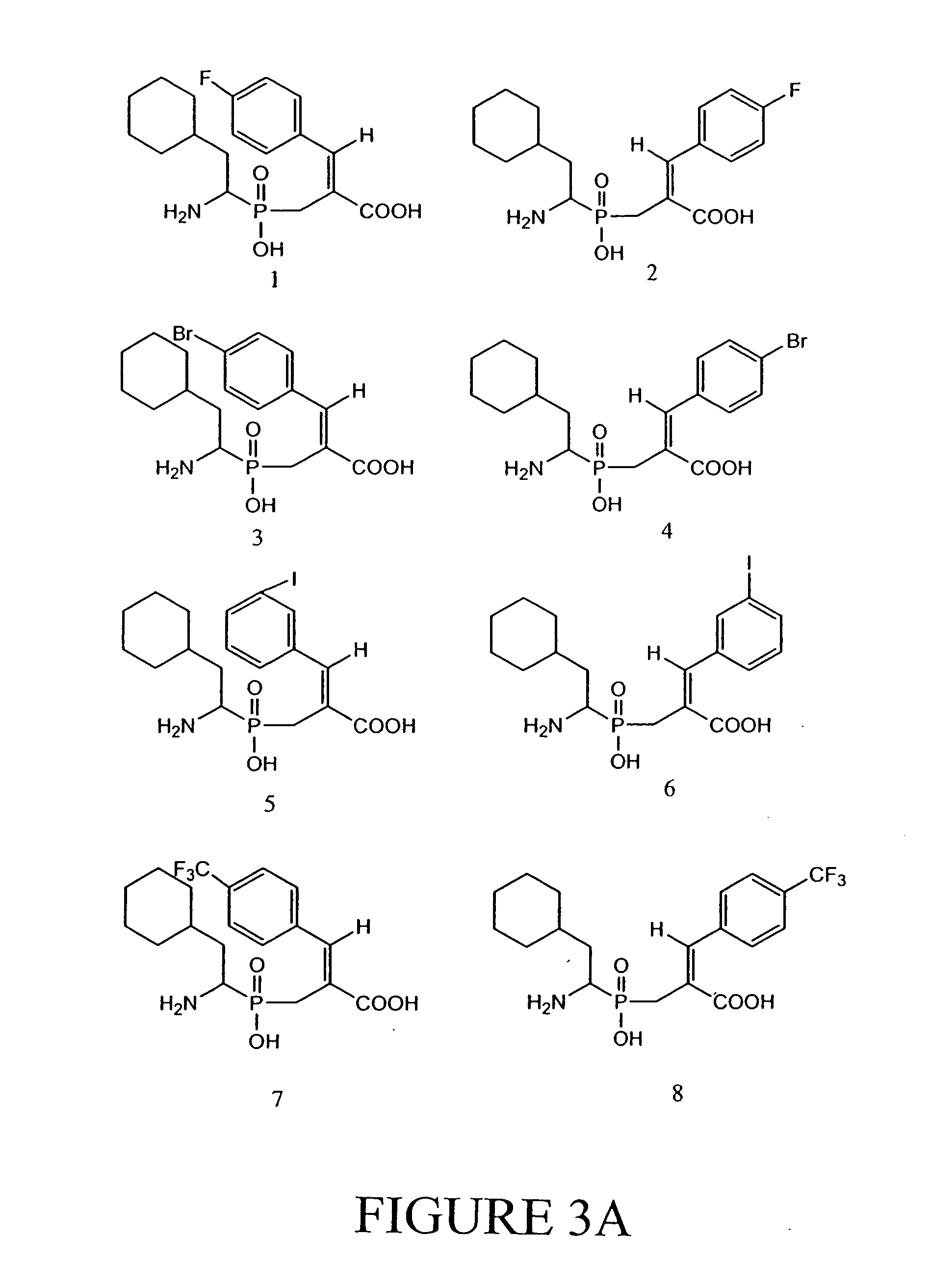Design and synthesis of renal dipeptidase inhibitors
- Summary
- Abstract
- Description
- Claims
- Application Information
AI Technical Summary
Benefits of technology
Problems solved by technology
Method used
Image
Examples
example 1
Synthesis of Compounds
[0058] Compounds were syntheszied using the Witting-Horner reaction. See FIG. 1. These stable tetrahederal phosphorus species act by mimicking the tetrahedral intermediates of the reactions catalyzed by the RDP enzyme.
[0059] We report here the synthesis and biological evaluation of new RDP inhibitors. The method employed for the preparation of aminophosphinic acid derivatives is outlined in FIG. 1. Compound 1 was prepared by the condensation of cyclohexylacetaldehyde, hypophosphoric acid and aminodiphenylmethanehydrochloride,11 followed by protection of the NH2 and P—OH groups with BOC and CH2N2,12 respectively. Reaction of 1 with trimethyl-2-phosphonoacrylate in the presence of NaOMe as base gave an intermediate, which subsequently underwent a Wittig-Horner olefination13 with aldehydes to give mixtures of E and Z isomers, which were separated by column chromatography over silica gel. The yields were 30-40% for the Z isomers and 20-30% for the E isomers. The ...
example 2
Assay for Activity of Compounds
[0060] The assay buffer was prepared by mixing 20 mM Tris, pH=8, 10 μM ZnCl2. 1 mM substrate (ε-DNP-L-Lys-D-Amp) stock solution in DMSO was prepared. Inhibitors were diluted from MeOH stock solution in water. 20μ of lysate was taken in 150 μl of assay buffer and 20 μl of inhibitor was added. The mixture was incubated at room temperature for 30 min. It was then transferred to plate temperature for 30 min. It was then transferred to plate containing 2 μl / well, 1 mM substrate in DMSO. After mixing incubated at 37° C. Florescence was measured at 30 sec intervals. The IC50 values were determined using small intestine lysate. Ki values were determined for selected compounds using colon cancer lysate.
example 3
Inhibitory Activity of Compounds
[0061] Compounds according to the invention were assayed as described in Example 2. Results of these assays are shown in Tables 1 and 2. Compounds 8, 10, and 12 appear to have the lowest IC50.
[0062] The RDP inhibition activity of these compounds was determined using crude lysates prepared from human colon cancers. The results are expressed as the concentration of inhibitor needed to inhibit enzyme activity by 50% (IC50). The data for the synthesised compounds are shown in Table 1. Human colon cancer extracts were prepared by homogenizing one cm3 of frozen colon tissue in 10 ml of 20 mM Tris, pH 8.0, 10 μM ZnCl2, 0.1% Triton X 100. The extract was clarified by centrifugation at 13,000× g for 5 minutes at 4° C. and, for each measurement, 20 μl was diluted into 158 μl of 20 mM Tris, pH 8.0, 10 μM ZnCl2. 20 μl of the synthesised compounds were added to each reaction to obtain final concentrations ranging from 0 to 10 μM. The mixtures were incubated at r...
PUM
| Property | Measurement | Unit |
|---|---|---|
| temperature | aaaaa | aaaaa |
| pH | aaaaa | aaaaa |
| pH | aaaaa | aaaaa |
Abstract
Description
Claims
Application Information
 Login to View More
Login to View More - R&D
- Intellectual Property
- Life Sciences
- Materials
- Tech Scout
- Unparalleled Data Quality
- Higher Quality Content
- 60% Fewer Hallucinations
Browse by: Latest US Patents, China's latest patents, Technical Efficacy Thesaurus, Application Domain, Technology Topic, Popular Technical Reports.
© 2025 PatSnap. All rights reserved.Legal|Privacy policy|Modern Slavery Act Transparency Statement|Sitemap|About US| Contact US: help@patsnap.com



